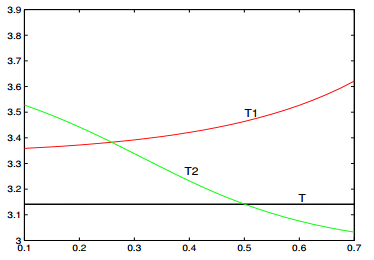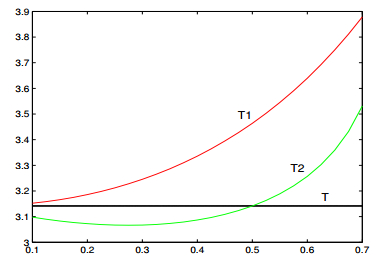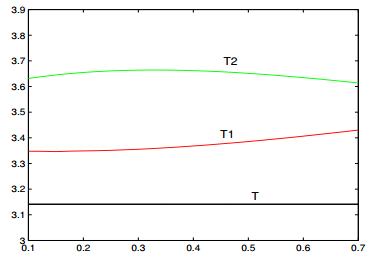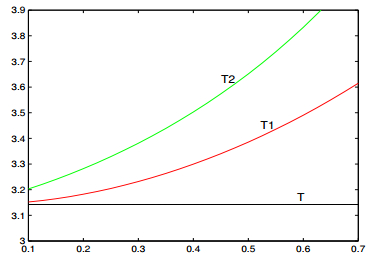1. Introduction
The theory of real business cycle and Keyneianism IS-LM model (Kynes J M, 1936) are two frameworks in macroeconomics which are both widely approved. Although the two theories are very different, they both follow Modigliani-Miller theorem, which says that financial factors make no difference to real economic variables. However, after American subprime mortgage crisis, the effects of financial factors on business cycle are becoming more remarkable (Alpanda S et al., 2014; Christiano L et al., 2007; Jerman U et al., 2012), which form the features of financial business cycle (Iacoviello M, 2015; Mimir Y, 2016). Firstly, the economy and financial factors have intimate connections (Claessens S et al., 2012). Secondly, the economy fluctuates continuously by shocks which are transmitted by monetary sector (Kamber G et al., 2013; Kollmann R, 2013). Thirdly, tiny change may be magnified by financial market such that it could lead to a big shock hitting on global economy (Luca D et al., 2009). These features have exceeded the research scope of classical theories of business cycle. It raises the need of a framework for analysis. Many economists and mathematical finance scholars have attempted to introduce financial factors into the frameworks of business cycle.
Under the framework of Keyneianism, both the well known Kaldor and Kalecki business cycle models use an investment function which is based on the profit principle rather than the acceleration principle. In the Kaldor (1940) model, the gross investment depends on the level of output and capital stock. For a given quantity of real capital, investment depends on the level of profit, which in turns depends on the level of activity. Kaldor presented the assumptions on nonlinear investment and savings function and their shift over time which give rise to a cycle. Thereafter, the model has been paid much attentions. Varian (1979) explored the possibility that the economic system possesses a unique limit cycle. The most important result was the paper (Chang W et al., 1971), where the model was reexamined and the necessary and sufficient conditions of the existence of a limit cycle were stated. The coexistence of a limit cycle and an equilibrium was considered by Grasman and Wentzel (1994). The Kalecki (1935, 1937) business cycle model was a few years earlier than the Kaldor one. Kalecki assumed that the saved part of profit is invested and the capital growth is due to past investment decisions. There is a gestation period or a time lag, after which capital equipment is available for production. Krawiec and Szydłwsk (1999, 2001) formulated the Kaldor-Kalecki business cycle model based on the multiplier dynamics which is the core of both the Kaldor and Kalecki's approach but followed Kalecki's idea to investment and of a time lag between investment decisions and implementation. They obtained a delay differential equation system and applied the Hopf bifurcation mechanism to create the limit cycle. They showed that the dynamics of the system depended crucially on the time delay parameter. Then they investigated the stability of the limit cycle (Szydłwsk M et al., 2005). Following the works of Krawiec and Szydłwsk, Kaddar and Alaoui (2008, 2009) proposed another delay Kaldor-Kalecki model of business cycle. They derived the similar results to those of Krawiec and Szydłwsk (1999, 2001). More other results about the Kaldor-Kalecki model can be referred to Bashkirtseva et al. (2016), De Cesare et al. (2012), Liao et al. (2005), Mircea et al. (2011), Wang et al. (2009), Wu (2012), Zhang et al. (2004). For example, Liao et al. (2005) studied chaos in the model. Wu (2012) carried out the zero-Hopf bifurcation of the model. Bashkirtseva et al. (2016) analyzed the stochastic effects in the discrete Kaldor-Kalecki model. Mircea et al. (2011) studied the Hopf bifurcation of the mean and variance of a stochastic Kaldor-Kalecki model.
The aim of this paper is to model business cycle under shocks and see the effects of shocks on the economic system. We introduce the financial shocks into the Kaldor-Kalecki model. The financial shocks are regarded as random noises perturbing the model and thus the model shows volatility and risky. Then we study the dynamics of the model in the framework of stochastic differential equations (Øksendal B et al., 2000) and random dynamical systems (Arnold L, 1988; Crauel H et al., 1999), which can help us understand the effects of financial shocks on business cycle and improve our knowledge of the law of financial business cycle. As we focus on the effects of financial shocks on the model, we omit the time-delay effect in the Kaldor-Kalecki model.
The paper is organized as follows. In Section 2, we simplify the Kaldor-Kalecki model into a normal form in the framework of ordinary differential equations. The normal form of the Kaldor-Kalecki model admits the same essence as the original Kaldor-Kalecki model, but just is more convenient to consider. Then by applying the polar transformation, the model is transferred into a more intuitionistic form and the existence of limit cycle, which implies the business cycle, is proved. In Section 3, we introduce shocks, which are regarded as noises, into the normalized Kaldor-Kalecki model and make it stochastic. The shocks include external shock and internal shock. Then the dynamics of the stochastic models with external shock, internal shock, both external shock and internal shock are investigated respectively in the framework of stochastic differential equations and random dynamical systems. We present conditions of intensities of shocks under which the system shows different kinds of dynamics, such as behaving randomly periodically, converging to normalcy, behaving uncertainly and disorderly. Especially, production of stable invariant measure of the random dynamical system associating with the stochastic model means that the system behaves randomly periodically, namely that the amplitude and velocity of period are random but stationary, whose laws are invariant with respect to time. In Section 4, we give some discussions about the effects of financial shocks on the economic system.
2. Kaldor-Kalecki Model
In this section, we simplify the Kaldor-Kalecki model to a normal form and prove the existence of limit cycle. The Kaldor macro business cycle model (Kaddar A et al., 2008) is a two-dimensional autonomous dynamical system in the form
|
{Y′=α(I(Y,K)−S(Y,K)),K′=I(Y,K)−qK,
|
(2.1)
|
where I is the nonlinear investment and S is the savings function, Y is gross product, K is capital stock, α is the adjustment coefficient in the goods market, and q is the depreciation rate of the capital stock. Similar to Kaddar's assumption (2008), we assume that the savings function S depends only on Y and is linear such that S(Y)=γY, γ>0. The investment function separates with respect to its two arguments and is linear with respect to K, that is I(Y,K)=I(Y)−βK, β>0. Then system (2.1) translates to the following differential equations
|
{Y′=αI(Y)−αβK−αγY,K′=I(Y)−(β+q)K.
|
(2.2)
|
It is easy to see that there is a non-trivial steady state (Y∗,K∗) such that
|
{I(Y∗)−βK∗−γY∗=0,I(Y∗)−(β+q)K∗=0.
|
(2.3)
|
Making a transformation of coordinates y=Y−Y∗, k=K−K∗, the system is translated into
|
{y′=α(i(y)−βk−γy),k′=i(y)−(β+q)k,
|
(2.4)
|
where i(y)=I(y+Y∗)−I(Y∗), which is similar to system (2.1) formally. Hence, without loss of generality, it is reasonable and convenient to consider (0,0) as the steady state which we will work on.
2.1. Normal Form of Kaldor-Kalecki Model
In this subsection, we carry out a normal form of the Kaldor-Kalecki model, which is a simplification without loosing essential information of the system. Suppose that I is a sufficiently smooth function. Expanding I at 0, system (2.2) is approximately translated into the following form:
|
{Y′=(αI′(0)−αγ)Y−αβK+α2I″(0)Y2+α6I‴(0)Y3+O(Y4),K′=I′(0)Y−(β+q)K+12I″(0)Y2+16I‴(0)Y3+O(Y4).
|
(2.5)
|
The eigenpolynomial of the system is given by
|
λ2+(αγ+β+q−αI′(0))λ+αβγ+αγq−αqI′(0)=0.
|
(2.6)
|
Supposing that λ=λr±λci are foots of (2.6), then λr is solved by
|
λr=12(αI′(0)−αγ−β−q).
|
(2.7)
|
Supposing that
|
(αγ+β+q−αI′(0))2−4αβγ−4αγq+4αqI′(0)<0,
|
(2.8)
|
then
|
λc=12√4αβγ+4αγq−4αqI′(0)−(αγ+β+q−αI′(0))2.
|
(2.9)
|
Making the transformation of coordinates
|
{ϕ=(−β−q−λr)Y+αβK,φ=λcY,
|
(2.10)
|
then system (2.5) is translated into the following form:
|
{φ′=λrφ−λcϕ+α2λcI″(0)φ2+α6λ2cI‴(0)φ3,ϕ′=λrϕ+λcφ+α(−q−λr)2λ2cI″(0)φ2+α(−q−λr)6λ3cI‴(0)φ3,
|
(2.11)
|
where we omit the high order terms. In the framework of normal form of ordinary differential equations, the system can be simplified into the following form:
|
{φ′=λrφ−λcϕ+(νφ−κϕ)(φ2+ϕ2),ϕ′=λcφ+λrϕ+(κφ+νϕ)(φ2+ϕ2),
|
(2.12)
|
where
|
ν=αI‴(0)16λ2c+α2I″2(0)8|λ|2λ2c(−2q−λr−(q+λr)2λrλ2c)
|
(2.13)
|
and
|
κ=−α(q+λr)I‴(0)16λ3c+α2I″2(0)4|λ|2λc(−(q+λr)λrλ2c+(q+λr)22λ2c−12).
|
(2.14)
|
The detailed procedure of simplification can be found in Appendix A.
2.2. Existence of Limited Cycle
Making the transformation of polar coordinates φ=rcosΘ, ϕ=rsinΘ, then we have
|
{r′=λrr+νr3,Θ′=λc+κr2.
|
(2.15)
|
If λr<0, ν>0 or λr>0, ν<0, letting λrr+νr3=0, one can get r=0, r=±√−λrν. Hence, r=√−λrν is a limited cycle.
Case Ⅰ. λr>0, ν<0. As r<√−λrν, r′>0. As r>√−λrν, r′<0. Hence, r=√−λrν is a stable limited cycle.
Case Ⅱ. λr<0, ν>0. As r<√−λrν, r′<0. As r>√−λrν, r′>0. Hence, r=√−λrν is a unstable limited cycle.
The period of the business cycle is given by
3. Stochastic Dynamics Driven by Financial Shocks
In Section 2, we have obtained a normal form (2.12) of the original system (2.5) and proved the existence of business cycle as long as the parameters satisfy λr<0, ν>0 or λr>0, ν<0. In the first case, the limited cycle is unstable. In the second case, the limited cycle is stable. Recalling that the aim of this paper is investigating the effects of financial shocks making on the economic system, in this section, we introduce the financial shocks into system (2.15), which is equivalent to system (2.12). The financial shocks are expressed as noises. Through out of this section, we assume that λr>0, ν<0.
3.1. Stochastic Model with External Shock
In this subsection, we introduce the financial shock into system (2.15) and get the following stochastic system
|
{r′=λrr+νr3+ϵrξt,Θ′=λc+κr2,
|
(3.1)
|
where ξt is a white noise. Note that the original equivalent solution r=√−λrν was destroyed by the noise. Hence, the noise can be interpreted as external shock (Øksendal B et al, 2001). In the following argument, we study the dynamics of system (3.1) in the framework of stochastic differential equations of ItÔ type and random dynamical system. We choose ItÔ interpretation and rewrite system (3.1) as
|
{dr=(λrr+νr3)dt+ϵrdB(t),dΘ=(λc+κr2)dt,
|
(3.2)
|
where B(t) is a Brownian motion defined on a probability space (Ω,F,{Ft}t≥0,P). Denote {θt}t∈R the classical Brownian shift on the probability space. According to the results given by Arnold (1998), there exists a unique local random dynamical system Φ such that (Φ(t,⋅)r0)t∈R is the unique maximal strong solution of (3.2) with initial value r0≥0. It is represented by
|
Φ(t,ω)r0=r0+∫t0(λrΦ(s,ω)r0+νΦ3(s,ω)r0)ds+ϵ∫t0Φ(s,ω)r0dB(s)
|
(3.3)
|
for t∈(τ−(r0,ω),τ+(r0,ω)), where τ+ and τ− are the forward and backward explosion times of the orbit Φ(⋅,ω)r0 starting at time t=0 in position r0. In the framework of stochastic bifurcation of random dynamical system, we have the following results:
Proposition 3.1. System (3.3) undergoes a stochastic pitchfork bifurcation at λr=ϵ22, and undergoes a P-bifurcation at λr=ϵ2. The generated non-trivial invariant measure supported on R+ is denoted by δr+, where
|
r+=(−2ν∫0−∞exp(2λrs−ϵ2s+2ϵB(s))ds)−12,
|
(3.4)
|
whose probability density function is given as
|
p+(r)=2(−ϵ2ν)12−λrϵ2Γ−1(λrϵ2−12)r(2λr−2ϵ2)/ϵ2eνϵ2r2.
|
(3.5)
|
The proof of Proposition 3.1 can be found in Appendix B. Returning to system (3.2), we have
|
{r+(θtω)=exp(λrt−ϵ22t+ϵB(t))/(−2ν∫t−∞exp(2λrs−ϵ2s+2ϵB(s))ds)12,Θ(t)=Θ0+λct+κ∫t0r2+(θsω)ds.
|
(3.6)
|
As r+ is a ergodic and stationary process, it can be regarded as a stochastic limited cycle of system (3.2), corresponding to the deterministic limited cycle of system (2.15). The mean of amplitude r+ can be calculated as
|
E[r+]=∫∞0rp+(r)dr=√−ϵ2νΓ(λrϵ2)Γ−1(λrϵ2−12).
|
(3.7)
|
The mean of r2+ can be calculated as
|
E+[r2+]=∫∞0r2p+(r)dr=−ϵ2νΓ(λrϵ2+12)Γ−1(λrϵ2−12),
|
(3.8)
|
which implies the mean of the rate Θ′(t) can be given as
|
E[Θ′(t)]=λc+κE[r2+]=λc−κϵ2νΓ(λrϵ2+12)Γ−1(λrϵ2−12).
|
(3.9)
|
In this way, the period of the limited cycle can be approximated by
|
T1=2πνΓ(λrϵ2−12)/(νλcΓ(λrϵ2−12)−κϵ2Γ(λrϵ2+12)).
|
(3.10)
|
If λr>ϵ2, it is easy to check that the maximum of probability density function is located at
which means that r∗ is the mode of r+. In this way, the period of the limited cycle can be approximated by
|
T2=2πνλcν+κϵ2−κλr.
|
(3.12)
|
3.2. Stochastic Model with Internal Shock
In the last subsection, we introduce the financial shock, which is considered as an external noise, into system (2.15). In this subsection, we introduce another financial shock into system (2.15) and get the following system
|
{r′=(1+ϵξt)r(λr+νr2),Θ′=λc+κr2,
|
(3.13)
|
where ξt is a white noise. As the original equivalent solution r=√−λrν is still a solution of the stochastic model (3.13), we interpret the noise as an internal shock. In the following argument, we study the dynamics of system (3.13) in the framework of stochastic differential equations of ItÔ type and random dynamical system as well. We choose ItÔ interpretation and rewrite system (3.13) as
|
{dr=r(λr+νr2)dt+ϵr(λr+νr2)dB(t),dΘ=(λc+κr2)dt,
|
(3.14)
|
where B(t) is a Brownian motion. The random dynamical system Φ associating with (3.14) with initial value r0≥0 can be represented by
|
Φ(t,ω)r0=r0+∫t0(λrΦ(s,ω)r0+νΦ3(s,ω)r0)ds+ϵ∫t0(λrΦ(s,ω)r0+νΦ3(s,ω)r0)dB(s).
|
(3.15)
|
Denote r+=√−λrν and r−=−√−λrν. It is easy to see that system (3.15) admits three trivial invariant measures δ0, δr+ and δr−. We are just interested in the case of r≥0. The following proposition tells the dynamics of system (3.15).
Proposition 3.2.
Let Φ be the system in (3.15) with initial value r0>0. Then
Case Ⅰ. If ϵ2λr<2, then Φ(t)r0→√−λrν almost surely as t→∞, which implies that δr+ is a stable Φ-invariant measure.
Case Ⅱ. If ϵ2λr>2 and r0<√−λrν, then
|
P(Φ(t)r0→√−λrν as t→∞)=f(r20)/f(−λrν)
|
(3.16)
|
and
|
P(Φ(t)r0→0 as t→∞)=1−f(r20)/f(−λrν),
|
(3.17)
|
where
|
f(x)=∫x0y−(1ϵ2λr+12)(−λrν−y)1ϵ2λrdy.
|
(3.18)
|
The proof of Proposition 3.2 can be found in Appendix C. The results of Proposition 3.2 tells that if the parameters of the system satisfy ϵ2λr<2, the limited cycle r=√−λrν is stable. If ϵ2λr>2, the limited cycle is stable in some probability less than one. The period of the limited cycle is the same as (2.16).
3.3. Stochastic Model with External and Internal Shocks
In the last two subsection, the dynamics of system (2.15) with external shock and internal shock are investigated respectively. In this subsection, we consider the system with both two kinds of shocks, namely that
|
{r′=(1+ϵ2ξ2t)r(λr+νr2)+ϵ1rξ1t,Θ′=λc+κr2,
|
(3.19)
|
where ξ1t and ξ2t are white noises. Similarly, the stochastic differential equation of ItÔ type of (3.19) can be rewritten as
|
{dr=r(λr+νr2)dt+ϵ1rdB1(t)+ϵ2r(λr+νr2)dB2(t),dΘ=(λc+κr2)dt,
|
(3.20)
|
where B1(t) and B2(t) are two Brownian motions satisfying ⟨B1,B2⟩t=ρt, −1≤ρ≤1. Dynamics of stochastic system with double noises can be referred to Huang (2016). The random dynamical system associating with (3.20) with initial value r0>0 can be represented by
|
Φ(t,ω)r0=r0+∫t0(λrΦ(s,ω)r0+νΦ3(s,ω)r0)ds+ϵ1∫t0Φ(s,ω)r0dB1(s)+ϵ2∫t0(λrΦ(s,ω)r0+νΦ3(s,ω)r0)dB2(s).
|
(3.21)
|
The following proposition shows the dynamics of system (3.21).
Proposition 3.3.
If γ<32, system Φ in (3.21) undergoes a stochastic pitchfork bifurcation at λr=α2 and undergoes a P-bifurcation at λr=α. The probability density function of the generated non-trivial invariant measure δr+ supporting on R+ is given as
|
p(r)=2√αr2+βr4+γr6exp(∫rc(2λr−α)+(2ν−2β)x2−3γx4αx+βx3+γx5dx)=Cr4λr−3αα(α+βr2+γr4)−α+λα−12exp(4αν−2βλrα√4αγ−β2arctan(β+2γx2√4αγ−β2)),
|
(3.22)
|
where
|
α=ϵ21+2ϵ1ϵ2ρλr+ϵ22λ2r,β=2ϵ1ϵ2ρν+2ϵ22λrν,γ=ϵ22ν2,
|
(3.23)
|
|
C=(∫∞0r4λr−3αα(α+βr2+γr4)−α+λα−12exp(4αν−2βλrα√4αγ−β2arctan(β+2γx2√4αγ−β2))dr)−1.
|
(3.24)
|
If γ>32, δ0 is the unique invariant measure. If λr<α2, then δ0 is stable. Otherwise, δ0 is unstable.
Detailed proof of Proposition 3.3 can be found in Appendix D. Returning to system (3.20), r+(θtω) is an ergodic and stationary process, which can be regarded as a stochastic limited cycle of (3.20), corresponding to the deterministic limited cycle. The mean of r+ is given as
|
E[r+]=∫∞0Cr4λr−2αα(α+βr2+γr4)−α+λα−12exp(4αν−2βλrα√4αγ−β2arctan(β+2γx2√4αγ−β2))dr.
|
(3.25)
|
The mean of r2+ is given as
|
E[r2+]=∫∞0Cr4λr−αα(α+βr2+γr4)−α+λα−12exp(4αν−2βλrα√4αγ−β2arctan(β+2γx2√4αγ−β2))dr.
|
(3.26)
|
and so as E[Θ′(t)]=λc+κE[r2+]. The approximated period of limited cycle is given as
|
T1=2πλc+κ∫∞0Cr4λr−αα(α+βr2+γr4)−α+λα−12exp(4αν−2βλrα√4αγ−β2arctan(β+2γx2√4αγ−β2))dr.
|
(3.27)
|
If λr>α, the maximum of the probability density function is located at
|
r∗=√(ν−2β)+√(2β−ν)2−12γ(α−λr)6γ,
|
(3.28)
|
which is the mode of r+. The corresponding approximated period of limited cycle is given as
|
T2=12πγ6λcγ+κ(ν−2β)+κ√(2β−ν)2−12γ(α−λr).
|
(3.29)
|
4. Discussions
In Section 3, we have studied the dynamics of the business cycle model with external shock, internal shock, both external and internal shocks respectively in the framework of stochastic differential equations and random dynamical systems. The dynamics of the model can acquaint us with the effects of shocks on the business cycle. In the case of external shock, if the intensity of the shock ϵ satisfies ϵ2<2λr, there exists an ergodic and stationary process r+(t) such that the original amplitude r=√−λrν of the business cycle transfers to r+(t), which volatilities randomly. The original velocity Θ′(t)=λcν−κλrν of the business cycle transfers to Θ′(t)=λc+κr2+, which is also stationary. By calculating the mean and mode of Θ′(t), we obtain two approximated estimations of period (3.10) and (3.12) in the case of external shock. Figure 1 shows the comparison among T, T1 and T2 as functions of ϵ. We can see that T1 and T2 are both larger than T for given an intensity of shock ϵ, namely that the period of business cycle may be enlarged due to the external shock. As the intensity of shock increases, the period of business cycle increases as well. If the intensity of shock satisfies ϵ2>2λr, the amplitude of the business cycle converges to 0, which means that the economic system converges to a normalcy (0,0) (Actually, (0,0) is not the real normalcy. One could understand this from (2.3), (2.4) and the context).
In the case of internal shock, if the intensity of shock satisfies ϵ2<2λr, the economic system admits the business cycle whose amplitude and velocity are the same as the original business cycle, so as the period.
If the intensity of shock satisfies ϵ2>2λr, the business cycle exists in some probability less than one. The system converges to a normalcy in residual probability. In summary, the system either behaves periodically or converges to a normalcy. It is uncertain. In the case of external and internal shocks acting on the system, the effects of shocks on the business cycle are more complicated. If the intensities of shocks ϵ1 and ϵ2 satisfy 2λr>ϵ21+2ϵ1ϵ2ρλr+ϵ22λ2r, ϵ22ν2<32, the economic system behaves randomly periodically as the case of external shock, namely that the original amplitude and velocity both transfer to stationary processes. We as well obtain two approximated periods given in (3.27) and (3.29). Figure 2 and Figure 3 show the comparison among T, T1 and T2 as functions of ϵ1 and ϵ2 respectively under the assumption that external shock and internal shock are positively correlation, namely that ρ>0. Figure 4 and Figure 5 show the same topic but under the assumption that external shock and internal shock are negatively correlation, namely that ρ<0. From the figures, we can see that T1 is always larger than T regardless of the correlation of shocks. From Figure 2 and Figure 4, we can see that T2 may decrease as the intensity ϵ2 increases. In contrast, T1 increases as ϵ2 increases. Figure 3 and Figure 5 tell that both T1 and T2 may increase as the intensity ϵ1 increases. On the other hand, from the increasing rate of T1, T2 and decreasing rate of T2 as functions of ϵ1 and ϵ2 in the figures, we can see the sensitivity of the period of the business cycle on the intensities of shocks. If the intensities of shocks satisfy 2λr<ϵ21+2ϵ1ϵ2ρλr+ϵ22λ2r, ϵ22ν2<32, the economic system converges to the normalcy. However, if the intensities of shocks satisfy 2λr<ϵ21+2ϵ1ϵ2ρλr+ϵ22λ2r, ϵ22ν2>32, the normalcy looses its stability and the system becomes disorder, which may implies the upcoming of economic crisis.
A. The procedure of simplification of the system
To simplify the original system, denoting Λ=arg(λ), we can rewrite (2.11) as
|
{φ′=|λ|cos2πΛφ−|λ|sin2πΛϕ+α2λcI″(0)φ2+α6λ2cI‴(0)φ3,ϕ′=|λ|sin2πΛφ+|λ|cos2πΛϕ−αq2λ2cI″(0)φ2+αq6λ3cI‴(0)φ3.
|
(A.1)
|
Then making the transformation of coordinates
|
φ=12z+12¯z, ϕ=−12zi+12¯zi,
|
(A.2)
|
that is
system (A.1) is translated into the following forms:
|
{z′=λz+a20z2+2a11zˉz+a02ˉz2+b30z3+3b21z2ˉz+3b12zˉz2+b03ˉz3,ˉz′=−λˉz+¯a20z2+2¯a11zˉz+¯a02ˉz2+¯b30z3+3¯b21z2ˉz+3¯b12zˉz2+¯b03ˉz3,
|
(A.4)
|
where
|
a:=a20=a11=a02=α8λcI″(0)−α(q+λr)8λ2cI″(0)i,
|
(A.5)
|
|
b:=b30=b21=b12=b03=α48λ2cI‴(0)−α(q+λr)48λ3cI‴(0)i,
|
(A.6)
|
Denote h2(z,¯z)=h220z2+h211z¯z+h202¯z2. Replacing z by z+h2(z,¯z) gives
|
z′(1+∂h2∂z)=λz+λ∂h2∂¯z¯z+λh2+a20z2+2a11z¯z+a02¯z2+O(z3,¯z3).
|
(A.7)
|
Therefore, h2 satisfies
|
−λ∂h2∂zz+λ∂h2∂¯z¯z+λh2+a20z2+2a11z¯z+a02¯z2=0.
|
(A.8)
|
It is easy to solve that
|
h220=a20λ, h211=−2a11λ, h202=−a023λ.
|
(A.9)
|
Omitting the high order terms, system (A.4) is translated to
|
z′=λz+f30z3+f21z2¯z+f12z¯z2+f03¯z3,
|
(A.10)
|
where
|
{f30=b30−2λh2220−2h220a20,f21=3b21−5λh220h211−h211a20−4h220a11,f12=3b12−6λh220h202−2λh2211−2h211a11−2h220a02,f03=b03−3λh211h202−h211a02.
|
(A.11)
|
Repeating the procedure above, denote h3(z,¯z)=h330z3+h321z2¯z+h312z¯z2+h303¯z3. Replacing z by z+h3(z,¯z), then h3 must satisfy
|
−λ∂h3∂zz+λ∂h3∂¯z¯z+λh3+f30z3+f21z2¯z+f12z¯z2+f03¯z3=0.
|
(A.12)
|
It is easy to solve that
|
h330=f302λ, h321=0, h312=−f122λ, h303=−f034λ.
|
(A.13)
|
Omitting the high order terms, system (A.10) is translated to
Recalling that z=φ+ϕi, then we have
|
{φ′=λrφ−λcϕ+(νφ−κϕ)(φ2+ϕ2),ϕ′=λcφ+λrϕ+(κφ+νϕ)(φ2+ϕ2),
|
(A.15)
|
where ν=Ref21, κ=Imf21. From the arguments above, we can get
|
ν=αI‴(0)16λ2c−α2I″2(0)8|λ|2λ2c(2q+λr+(q+λr)2λrλ2c)
|
(A.16)
|
and
|
κ=−α(q+λr)I‴(0)16λ3c+α2I″2(0)4|λ|2λc(−(q+λr)λrλ2c+(q+λr)22λ2c−12).
|
(A.17)
|
B. Proof of Proposition 3.1
The backward cocycle over ˜θ:=θ−1 corresponding to (3.2) is given by ˜Φ(t,ω)r0:=Φ(−t,ω)r0. It is generated by the stochastic differential equation
|
d˜r=−λr˜rdt−ν˜r3dt+ϵ˜rdB(−t).
|
(B.1)
|
First we restrict system Φ on R+. The Fokker-Plank equations of (3.2) and (B.1) are given respectively as
|
∂∂tp(t,r)=∂2∂r2(ϵ22r2p(t,r))−∂∂r((λrr+νr3)p(t,r))
|
(B.2)
|
and
|
∂∂t˜p(t,r)=∂2∂r2(ϵ22r2˜p(t,r))+∂∂r((λrr+νr3)˜p(t,r)),
|
(B.3)
|
whose time-homogeneous solutions can be solved by
|
p(r)=Cr(2λr−2ϵ2)/ϵ2exp(νϵ2r2), ˜p(r)=Cr−2λrϵ2exp(−νϵ2r2).
|
(B.4)
|
Then m(dr)=p(r)dr is the speed measure of Φ, which is an invariant measure of Markov semigroup Pt associating with (3.2). ˜m(dr)=˜p(r)dr is the speed measure of ˜Φ, which is an invariant measure of Markov semigroup ˜Pt associating with (B.1). Recall from Chapter 2 in Crauel and Gundlach (1999) that there is a bijection between the invariant probability measures of the semigroup and the Φ-invariant measures. If λr<ϵ22, m(R+) and ˜m(R+)=∞, which both can not be normalized. We conclude that there is no other Φ-invariant measures except δ0. To see the stability of invariant measure, we can calculate the Lyapunov exponent. The linearization of Φ, DΦ(t,r) satisfies
|
dDΦ(t,r)=(λr+2νr2)DΦ(t,r)dt+ϵDΦ(t,r)dB(t)
|
(B.5)
|
with solution
|
DΦ(t,r)v=vexp(∫t0(λr−ϵ22+2νr2(s))ds+ϵB(t)).
|
(B.6)
|
The Lyapunov exponent of δ0 satisfies
|
λΦ(δ0)=limt→∞1tlogDΦ(t,0)=limt→∞1tlogexp(∫t0(λr−ϵ22+2ν⋅0)ds+ϵB(t))=λr−ϵ22<0,
|
(B.7)
|
which implies that δ0 is stable. If λr>ϵ22, then m(R+)<∞ and ˜m(R+)=∞. Moreover, for any c>0, ˜m(R+/[0,c])=∞, which implies that Φ is forward complete (see Lemma 2.6 in Chapter 2 in Crauel and Gundlach (1999)). Hence, there exists a random variable, denoted by r+, such that δr+(ω)=limt→∞Φ(t,˜θtω)m/m(R+) is an ergodic Φ-invariant measure. Moreover,
|
r(ω)=1/(−2ν∫0−∞exp(2λrs−ϵ2s+2ϵB(s))ds)12
|
(B.8)
|
and
|
r(θtω)=exp(λrt−ϵ22t+ϵB(t))/(−2ν∫t−∞exp(2λrs−ϵ2s+2ϵB(s))ds)12.
|
(B.9)
|
The system occurs a D-bifurcation at λr=ϵ22. To see the stability of δr+, we first give an estimation. Denote R(r)=r2(t), where r is the solution of (3.2) with initial value r0>0. Then R satisfies
|
R(t)=exp(2λrt−ϵ2t+2ϵB(t))/(1r20−2ν∫t0exp(2λrs−ϵ2s+2ϵB(s))ds).
|
(B.10)
|
Denote
|
Z(t)=1r20−2ν∫t0exp(2λrs−ϵ2s+2ϵB(s))ds.
|
(B.11)
|
It is easy to see that
|
∫t0R(s)ds=−12νlogZ(t)+12νlogZ(0).
|
(B.12)
|
By Doob's inequality
|
P(sup0≤s≤t|B(s)|≥ht)≤exp(−h22t), ∀h>0,
|
(B.13)
|
we have
|
P(1r20−2ν2λr−ϵ2exp((2λr−ϵ2−2ϵh)t)+2ν2λr−ϵ2exp(−2ϵht)≤Z(t)≤1r20−2ν2λr−ϵ2exp((2λr−ϵ2+2ϵh)t)+2ν2λr−ϵ2exp(2ϵht))≥1−exp(−h22t).
|
(B.14)
|
It is easy to see that there exists T>0, such that for t≥T,
|
P(−2ν2λr−ϵ2exp((2λr−ϵ2−2ϵh)t)≤Z(t)≤−2ν2λr−ϵ2exp((2λr−ϵ2+2ϵh)t))≥1−exp(−h22t),
|
(B.15)
|
that is
|
P(−12νlog(−2ν2λr−ϵ2)−12ν(2λr−ϵ2−2ϵh)t≤−12νlogZ(t)≤−12νlog(−2νλr−ϵ2)−12ν(2λr−ϵ2+2ϵh)t)≥1−exp(−h22t),
|
(B.16)
|
which implies
|
−12ν(2λr−ϵ2−2ϵh)≤−12νlimt→∞1tlogZ(t)≤−12ν(2λr−ϵ2+2ϵh).
|
(B.17)
|
Since h is arbitrary, we have
|
limt→∞1t∫t0R(s)ds=−12νlimt→∞1tlogZ(t)=12ν(ϵ2−2λr)
|
(B.18)
|
almost surely. Applying this result, the Lyapunov exponent of λΦ(δr+) satisfies
|
λΦ(δr+)=limt→∞1tlogDΦ(t,r+)=limt→∞1t∫t0(λr−ϵ22+2νr2+(θsω))ds=λr−ϵ22+2νlimt→∞1t∫t0r2+(θsω)ds=λr−ϵ22−2λr+ϵ2=−λr+ϵ22<0,
|
(B.19)
|
which implies that δr+ is stable. At the same time, δ0 becomes unstable. If ϵ22<λr<ϵ2, the maximum of p is located at r=0. If λr>ϵ2, the maximum of p is located at r∗, where
Therefore the system occurs a P-bifurcation at λr=ϵ2. Restricting Φ on R− and following the arguments above, similarly, we can obtain another ergodic Φ-invariant measure, denoted by δr−, which is also stable. Hence, we conclude that the system occurs a pitchfork bifurcation at λr=ϵ22.
C. Proof of Proposition 3.2
Denote R(t)=r2(t). Then by ItÔ's formula, we have
|
dR=R(2+λrϵ2+ϵ2νR)(λr+νR)dt+2ϵR(λr+νR)dB(t).
|
(C.1)
|
Denote Y(t)=logR(t)λr+νR(t)=logR(t)−log(λr+νR(r)). Again by ItÔ's formula, we have
|
dY=(2λr−ϵ2λ2r−3λrϵ2νR)dt+2ϵλrdB(t),
|
(C.2)
|
or
|
logR(t)λr+νR(t)=logR0λr+νR0+(2λr−ϵ2λ2r)t−3λrϵ2ν∫t0R(s)ds+2ϵλrB(t),
|
(C.3)
|
where we have assumed that B(0)=0. By Doob's inequality (C.4), we have
|
P(logR(t)λr+νR(t)≥logR0λr+νR0+(2λr−ϵ2λ2r)t−2ϵλrht)≥1−exp(−h22t),
|
(C.4)
|
where R0>0 is the initial condition. Since ϵ2λr<2, namely 2λr−ϵ2λ2r>0 and h>0 is arbitrary, we have
|
lim_t→∞logR(t)λr+νR(t)≥logR0λr+νR0+lim_t→∞(2λr−ϵ2λ2r−2ϵλrh)t=∞
|
(C.5)
|
almost surely, which is possible only if limt→∞R(t)=−λrν almost surely.
For a function f∈C2(R+), by ItÔ's formula, we have
|
df(R)=f′(R)dR+12f″(R)d⟨R⟩=f′(R)R(2+λrϵ2+ϵ2νR)(λr+νR)dt+2ϵf′(R)R(λr+νR)dB(t)+2ϵ2f″(R)R2(λr+νR)2dt.
|
(C.6)
|
Letting f satisfy
|
f′(R)R(2+λrϵ2+ϵ2νR)(λr+νR)+2ϵ2f″(R)R2(λr+νR)2=0,
|
(C.7)
|
we can solve that
|
f(R)=∫R0x−(1ϵ2λr+12)(−λrν−x)1ϵ2λrdx.
|
(C.8)
|
For 0<R0<−λrν,
|
limt→∞E[f(R(t))]=f(−λrν)P(R(t)→−λrν as t→∞).
|
(C.9)
|
On the other hand, since f(R(t)) is a martingale, we have
|
f(R0)=f(−λrν)P(R(t)→−λrν as t→∞),
|
(C.10)
|
namely that
|
P(R(t)→−λrν as t→∞)=f(R0)/f(−λrν),
|
(C.11)
|
which implies that
|
P(R(t)→0 as t→∞)=1−f(R0)/f(−λrν).
|
(C.12)
|
D. Proof of Proposition 3.3
Making the transformation
|
{B1(t)=˜B1(t),B2(t)=ρ˜B1(t)+√1−ρ2˜B2(t),
|
(D.1)
|
it is easy to check that ⟨˜B1,˜B2⟩=0, namely that ˜B1 and ˜B2 are mutually independent Brownian motions. First equation in system (3.20) can be rewritten as
|
dr=r(λr+νr2)dt+(ϵ1r+ρϵ2r(λr+νr2))d˜B1(t)+√1−ρ2ϵ2r(λr+νr2)d˜B2(t),
|
(D.2)
|
which is equivalent in law to the following equation
|
dx=((λr−α2)x+(ν−β)x3−32γx5)dt+√αx2+βx4+γx6∘d˜B(t),
|
(D.3)
|
where
|
α=ϵ21+2ϵ1ϵ2ρλr+ϵ22λ2r,β=2ϵ1ϵ2ρν+2ϵ22λrν,γ=ϵ22ν2,
|
(D.4)
|
associating with random dynamical system ˜Φ represented by
|
Ψ(t,ω)x0=x0+∫t0((λr−α2)Ψ(s,ω)x0+(ν−β)Ψ3(s,ω)x0−32γΨ5(s,ω)x0)ds+∫t0√αΨ2(s,ω)x0+βΨ4(s,ω)x0+γΨ6(s,ω)x0∘d˜B(s)
|
(D.5)
|
with initial value x0>0. The backward cocycle over ˜θ corresponding to (D.5) is given by ˜Ψ(t,ω)x0:=Ψ(−t,ω)x0, which is generated by the stochastic differential equation
|
d˜x=(−(λr−α2)˜x−(ν−β)˜x3+32γ˜x5)dt+√α˜x2+β˜x4+γ˜x6∘d˜B(−t).
|
(D.6)
|
The Fokker-Plank equations of (D.3) and (D.6) can be written as
|
∂∂tp(t,x)=∂2∂x2(12(αx2+βx4+γx6)p(t,x))−∂∂x((λrx+νx3)p(t,x))
|
(D.7)
|
and
|
∂∂t˜p(t,x)=∂2∂x2(12(αx2+βx4+γx6)˜p(t,x))+∂∂x((λrx+νx3)˜p(t,x)),
|
(D.8)
|
whose time-homogeneous solutions can be solved by
|
p(x)=2√αx2+βx4+γx6exp(2∫xc(λr−α2)y+(ν−β)y3−32γy5αy2+βy4+γy6dy)
|
(D.9)
|
and
|
˜p(x)=2√αx2+βx4+γx6exp(2∫xc−(λr−α2)y−(ν−β)y3+32γy5αy2+βy4+γy6dy).
|
(D.10)
|
m(dx)=p(x)dx is an invariant measure of the Markov semigroup associating with (D.3) and ˜m(dx)=˜p(x)dx is an invariant measure of Markov semigroup associating with (D.6). If x>0 is small enough, it is easy to see that
|
exp(2∫xc(λr−α2)y+(ν−β)y3−32y5αy2+βy4+γy6dy)≈exp(2λr−αα∫xc1ydy)=Cx2λr−αα
|
(D.11)
|
and
|
exp(2∫xc−(λr−α2)y−(ν−β)y3+32y5αy2+βy4+γy6dy)≈exp(α−2λrα∫xc1ydy)=Cxα−2λrα,
|
(D.12)
|
which implies that for x>0 is small enough, p(x)≈Cx2λr−2αα and ˜p(x)≈Cx−2λrα. If x>0 is large enough, it is easy to see that
|
exp(2∫xc(λr−α2)y+(ν−β)y3−32y5αy2+βy4+γy6dy)≈exp(−3γ∫xc1ydy)=Cx−3γ
|
(D.13)
|
and
|
exp(2∫xc−(λr−α2)y−(ν−β)y3+32y5αy2+βy4+γy6dy)≈exp(3γ∫xc1ydy)=Cx3γ,
|
(D.14)
|
which implies that for x>0 large enough, p(x)≈Cx−3−3γ and ˜p(x)≈Cx−3+3γ. If λr>α2, m(R+)<∞ and ˜m(R+)=∞. If γ<32, then for any c>0, ˜m(R+/[0,c])=∞. From Lemma 2.6 in Chapter 2 in Crauel and Gundlach (1999), Ψ is forward complete. Hence, there exists a random variable x+ such that δx+=limt→∞Ψ(t,˜θtω)m/m(R+) is an ergodic invariant measure. If λr<α2, γ>32, then ˜m(R+)<∞ and m(R+)=∞. But for any c>0, m(R+/[0,c])<∞, which implies that Ψ is not backward complete. Hence, there is no other invariant measures except δ0. We conclude that system occurs a D-bifurcation at λr=α2, γ=32. Now let γ<32. If α2<λr<α, the maximum of p is located at 0. If λr>α, the maximum of p is located at x∗, where x∗ satisfies
|
3γx4∗+(2β−ν)x2∗+α−λr=0,
|
(D.15)
|
which can be solved as
|
x∗=√(ν−2β)+√(2β−ν)2−12γ(α−λr)6γ.
|
(D.16)
|
We conclude that system occurs a P-bifurcation at λr=α. The aforesaid results for Ψ hold for Φ as well, namely that Φ occurs D-bifurcation at λr=α2, γ=32. We denote the generated non-trivial invariant measure as δr+. Φ occurs P-bifurcation at λr=α, the maximum of the probability density function is located at r∗=x∗. To see the stabilities of the invariant measures, we calculate the Lyapunov exponents. The linearization of Φ, DΦ(t,r) satisfies
|
dDΦ(t,r)=(λr+3νr2)DΦ(t,r)dt+(ϵ1+ρϵ2λr+3ρϵ2νr2)DΦ(t,r)d˜B1(t)+√1−ρ2ϵ2(λr+3νr2)DΦ(t,r)d˜B2(t).
|
(D.17)
|
By ItÔ's formula, it is easy to check that
|
1tlogDΦ(t,r)v=1tlogv+λr+3ν1t∫t0r2(s)ds−12t∫t0(ϵ1+ρϵ2λr+3ρϵ2νr2(s))2ds−12(1−ρ2)ϵ221t∫t0(λr+3νr2(s))2ds+1t∫t0(ϵ1+ρϵ2λr+3ρϵ2νr2(s))d˜B1(s)+√1−ρ2ϵ21t∫t0(λr+3νr2(s))d˜B2(s)=1tlogV+λr−α2+3(ν−β2)1t∫t0r2(s)ds−92γ1t∫t0r4(s)ds+(ϵ1+ρϵ2λr)1t˜B1(t)+3ρϵ2ν1t∫t0r2(s)d˜B1(s)+√1−ρ2ϵ2λr1t˜B2(t)+3√1−ρ2ϵ2ν1t∫t0r2(s)d˜B2(s).
|
(D.18)
|
Taking logarithm in (D.2) and dividing by t, we have
|
1tlogr(t)=1tlogr0+λr+ν1t∫t0r2(s)ds−12t∫t0(ϵ1+ρϵ2(λr+νr2(s)))2ds−12(1−ρ2)ϵ221t∫t0(λr+νr2(s))2ds+1t∫t0(ϵ1+ρϵ2(λr+νr2(s)))d˜B1(s)+√1−ρ2ϵ21t∫t0(λr+νr2(s))d˜B2(s)=1tlogr0+λr−α2+(ν−β2)1t∫t0r2(s)ds−γ21t∫t0r4(s)ds+(ϵ1+ρϵ2λr)1t˜B1(t)+ρϵ2ν1t∫t0r2(s)d˜B1(s)+√1−ρ2ϵ2λr1t˜B2(t)+√1−ρ2ϵ2ν1t∫t0r2(s)d˜B2(s).
|
(D.19)
|
By Doob's inequality, we know that limt→∞1t˜B1(t)=limt→∞1t˜B2(t)=0 almost surely. Since r+(θtω) is ergodic and stationary process, letting r(t)=r+(θtω) in (D.19) and t→∞, we have
|
limt→∞((ν−β2)1t∫t0r2+(θsω)ds−γ2t∫t0r4+(θsω)ds+ρϵ2ν1t∫t0r2+(θsω)d˜B1(s)+√1−ρ2ϵ2ν1t∫t0r2+(θsω)d˜B2(s))=α2−λr
|
(D.20)
|
almost surely. If λr>α2, associating with (D.18) and (D.20), we have
|
limt→∞1tlogDΦ(t,r+)V=−2(λr−α2)−3γlimt→∞1t∫t0r4+(θsω)ds<0
|
(D.21)
|
almost surely, which implies the stability of the invariant measure δr+. At the same time, it is easy to check that
|
limt→∞1tlogDΦ(t,0)V=λr−α2>0
|
(D.22)
|
almost surely, which implies that δ0 is unstable. If λr<α2, then δ0 is stable. On the other hand, restricting Φ on R− and following the arguments above, we obtain another ergodic invariant measure supporting on R−, which is also stable if λr>α2, γ<32. We conclude that if γ<32, system Φ occurs a pitchfork bifurcation at λr=α2.
Acknowledgments
We are grateful to the fund project-the Key Subject Funds of Guangzhou Financial Research (No.16GFR02B09) providing us with funding support.
Conflict of Interest
The author declares no conflict of interest in this paper.









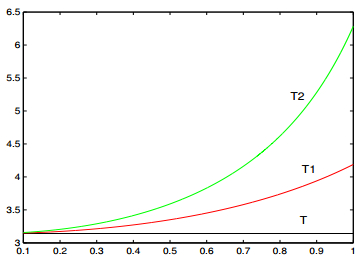
 DownLoad:
DownLoad: 